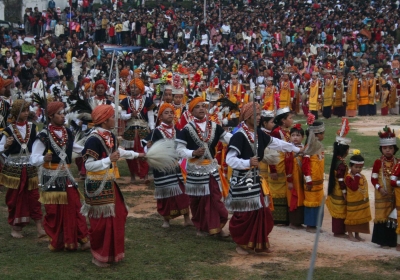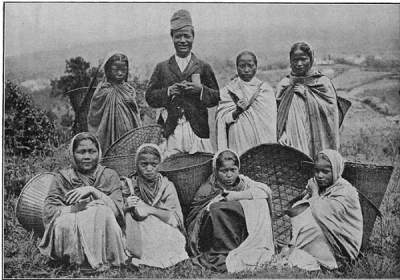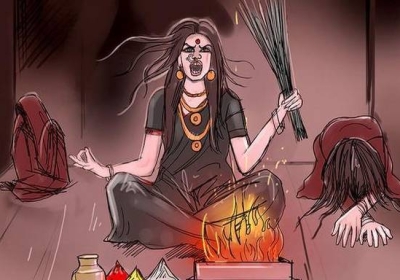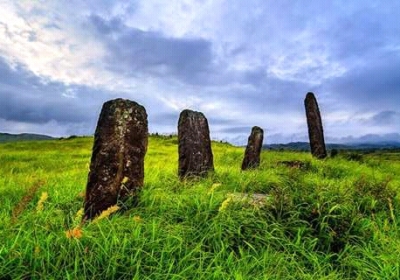KHASI MATRILINEAL CLAN LINEAGE: THE UNIVERSAL DIVINE ENTITY
The human being is an animate creature capable of motion, and each basic human action and movement become a practice; every repeated practice inculcated experience; the consecutive and constant experience turns in to a habit.So the frequency of regular habit, whether pleasant or coarse might influence others and they could imitate and in the course of time it might becomes a custom that spread to the neighbourhood and around the periphery. The regular custom for certain generations is ascribed as a tradition and meticulous tradition became a faith that the people believed on something that is proven effective to human relationship in the society and in the Khasi concept of indigenous faith it ends there and is forbidden to impose upon others. The belief system is confined to an individual and the conventional practice of an individual became a collective custom within the family, while the family members rely on the elders or heads of the family. If any individual is apprehensive of the practice, he or she may discover a different practice that needs to be refined and enable to convince the other members in the family, provided it does not cause any harm to others before it can percolate to the society. This is the quest for the divine that stayed and waited for the word, in Khasi 'Ap Jingong'. The word is believed to be the covenant between human and the divine, which is represented through the forces of Nature. In this regard, one distinct comparison may be drawn to clarify on the matter; the Hindu tradition of the subordinate or devotee of certain individual express their respect by touching the feet of that person of certain esteemed position or status in society, whereas in Khasi tradition it is not considered proper because of the egalitarian tradition. On the other hand, the Khasi tradition of respect and decency in society is that any individual irrespective of status or position should not walk across between any two person or more in a public gathering, whether formal or informal congregation particularly during conversation or interaction. It is customary that the nobles or royal persons would bowed down with verbal utterance of excuse while walking across the section of people gathering, even if they are ordinary citizens or subjects. The purpose is the same but the action is different and it reflected the thought process of the respective community. In Khasi tradition it may be considered improper to touch somebody's feet, unless the purpose is for lending a hand to rescue from any mishap or to to help because of injury or any such specific purposes.We have our own rules of etiquette to show respect. Whereas, other culture of the world would not hesitate to walk in front and across people during conversation or interaction, even in a formal assemblage, such behaviour would be bad manners or indecent in Khasi culture. Fundamentally, in Khasi culture one should not look up to somebody or look down on anybody, but to look at everyone asanequal with respect. That is why the chieftain of the province is categorised as 'the emperor,the slave' or 'U Syiem U Mraw' to substantiate the egalitarian concept; and 'the emperor, the mother' or 'U Syiem U Kmie' to revere the chieftain as the responsible and caring mother of her children, that is in his relationship with the citizens and subjects of the province or the State.
The Khasi concept of faith is universal and does not abide by any rigid traditional practice, while the practitioners of certain religious performances would prefer their own tradition, as they may think fit and proper with the surrounding environment. There are no specific names for the divine entity and they are abstract character for specific function. The word 'Blei' denotes omnipotence and omniscience of the ultimate divine being without digit or gender, and the other deities are associated with specific matters like land, home, nature, mountain, river, forest, cave, wealth, purity, fertility, prosperity, trade, administration, journey, welfare, hunting, pastime and a wide range of issues. There are certain nomenclature which could be a derivation or influence from other tradition from the neighbouring areas. For example the domestic deity or home deity is known as 'lei ïing' is also commonly called 'Lukhimai', which could be the equivalent of the Hindu goddess Laxmi; the deity of aesthetic and structural design is known as 'Biskorom', which could be equivalent of the Hindu god Viswakarma. The deity 'Lukhimai' or 'Lukhmi' as being called in the Bhoi region, is the deity associated with paddy or rice, the vital staple food for basic nourishment of human being. It is interesting to note that Biskorom is always address in consonance with the twelve masons or 'Khatar kamar' and nine carpenters 'Khyndai kamar' who are the stone masons and wood artisans for structural construction, while 'Biskorom' is the architect or artist for aesthetic design and durable engineering; otherwise the deities are generally termed as 'Ryngkew Basa' and symbolises with natural objects like stone, water, tree or any specific natural formation, which is believed to possess the spirit of a particular deity. The term 'Ryngkew' also literally means the earth surface and 'Basa' means the makeshift hut, which signify the aura of the divine that persists on the surface of the planet and in the celestial enclosure.
A Khasi diviner or a priest and priestess prays to the universal divine entity without specific identity in terms of form or gender or digit and the only visible image is the symbols of natural objects. It is trancendental in nature and embraced all the other divine entities of the entire world, and this is evident from the general devotional involvement that is inclusive of the diverse races on the planet. The Khasi diviner or priest or priestess would not refrained to mention God, Bhagwan, Allah, Yahweh, Buddha or terms like 'om', 'amen', 'mashallah' in the prayer. The offering articles are also being used with any material that has a purpose for the divine intervention. Usually, rice grains, egg, cowries are used in prayers, but there is no restriction to use fruit, banana, incense sticks, or anything that serves the purpose of sacred ceremonies. In the Khasi sacrificial rituals cows, pigs and goats are used besides the rooster, which is mandatory; however if any community is forbidden with any of the animal sacrifice, it could be avoided and provide with alternative materials, as long as it serves the purpose of the performance in their favour. Within the Khasi community also, there are certain clans that abstain from certain articles and considered taboo, such articles could be avoided in the performance of rituals.. During the 'Rongkhli' festival and ceremony at Nongtalang, a leopard was sacrificed after the traditional hunting expedition and every participant is compulsory to partake with its meat, but I did not consume it because our clan 'War Nongjri' is forbidden to take anything from the body of any feline because of the sacred communion with the tiger. Similarly, there are Khasi clans that are forbidden to use pumpkin, fish, pork, cucumber and other types of products because of certain sacred communion with the origin of the clan. There is no apprehension, speculation or suspicion on the matter and the festival and ceremony has to carry on with or without such situations, because faith, tradition, custom has to prevail all the time at all places. Moreover, the practice is held in congenial atmosphere even if someone is desired to refrain from certain compulsory participation due to subjective conditions and everybody respect their specific customary provisions. Unlike the unscrupulous cow vigilante in most parts of mainland India, the Khasi ceremonies and festivities are being held in harmony amidst diverse customary practices of certain clans within the community. The Khasi notion of the divine is compassion and empathy, tolerance and forgiveness, affection and inclusion in the sacred abode of humanity.
In real terms, the idea of god is not there in the pure Khasi faith, because god is not representational of any specific entity because the divine is ascribed as omnipotent, omnipresence and omniscient. This is to comprehend that the souls of every beings in the universe is the divine component, without any specific gender or number or any such constituent. It is one and the whole. It is the perfect combination of animism, humanism and astrology. The divine is reverence to the entire celestial beings, the nature and its components and to fellow humans as a whole. In the context of the heavenly bodies, human does not have any access to encounter and perceive the divine. In the context of environment everything in the nature is divine and it is sacrilege to harm the environment. In the context of humanity and sociology every good and pious person is divine, while every bad and evil person is also the constituent of that divine entity that fellow human needs to tolerate and reconcile, but not to abuse or cast aspersion on such elements; in other words it means forgiveness. Significantly, in the Khasi perspective the enemy, the criminal, the mischievous, the malevolent spirit collectively is or are the divine constituents, as much as the honest, compassionate and tolerant persons or spirits. Essentially, in the Khasi standpoint, God, Allah, Bhagwan, Yahweh, Jesus Christ, Ram, Krishna, Shiva, Guru Nanak, Ramakrishna, Vivekananda, Mahatma Gandhi, Mother Teresa et al; parents, siblings, uncles, aunts, friends, priests, monks and nuns, yogis, mystics, sages and several other good elements are one single divine entity. The deity and demon, good and evil are just the two sides of the same coin. The sacred Khasi faith is probably the most secular and democratic form of belief system that have been misinterpreted by the undesirable burden of ideology and philosophy enforced by the present advocates and champions of Khasi religion. The most important feature of Khasi faith is that it confines to an individual or the kinship family or the maternal clan and that it should never be preached, propagated, influenced or imposed upon another individual or family or clan or any community at large. This is the genuine Khasi faith or belief system or religion which ever preferential term that people opt to identify.







